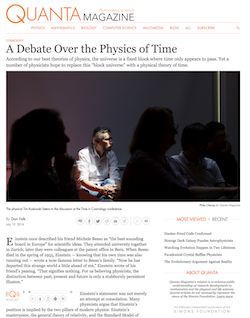2 October 2016 Prior homepage Next homepage: On Hawking & Guth
Page Contents
81018: An introduction to time, Max Tegmark, and the finite and infinite
Article. Dan Falk, Quanta Magazine & Atlantic Monthly: The Debate Over Time
Book. Richard A. Muller, Now: The Physics of Time
Conference. Time in Cosmology, Perimeter Institute for Theoretical Physics
Time. Our simple mathematical progression and simple logic provide a radically different approach to historic questions about time. If you multiply the smallest unit of time by 2, then each result by 2, over and over again, in just over 200 steps you will be at the Age of the Universe. It is hard to believe. That it is a view of the entire universe is hard to believe. That logically-speaking it is the most-simple, most-integrated, most-comprehensive grid that can be defined is just as hard to believe. Called base-2 notation from the Planck Scale to the Age of the Universe, this simple model suggests that space-and-time are finite, derivative, local, and quantized. The net-net, bottomline conclusion: What you do today imprints on the universe forever. Go to that model and all the numbers.
If space and time are finite, one might then ask, “Then, what is infinite?”
Infinity Is a Beautiful Concept – And It’s Ruining Physics: An article in Discover magazine, here Max Tegmark explores questions that surround infinity. Tegmark, a physics professor at MIT and the author of books like Our Mathematical Universe, has written hundreds of articles, and has done thousands of interviews and lectures. Infinity gets in his way (see: renormalization and regularization). He concludes that science does not need the infinite. This is an increasingly popular position among many very smart people. Although his conclusion is perhaps too quick, his engagement of the key questions is very good. More…
If space and time are finite, one might ask, “Is there anything that is infinite?” As a result of the simple base-2 model, a most simple answer could be “Continuity, symmetry, and harmony.” Order, relations, and dynamics – it appears that the thrust of the universe and the thrust of our cells require all three. To explore what that means, we will use the simple model to see how it impacts every article (including Max Tegmark’s), book, conference, and late night discussion about the nature of time referenced here. That base-2 simple chart...
This is a working document; it will continue to be updated. It will evolve in time.
Understanding the Universe By Engaging Just 202 Highly Distinctive, Length-Time Blocks
Seemingly Endless Debate About The Nature Of Time
Article. A Debate Over the Physics of Time by Dan Falk
Quanta Magazine, July 19, 2016 and Atlantic Monthly , July 26, 2016 (just a week later)
Dan Falk is the author of In Search of Time and a distinguished science writer from Toronto. In this article, first published by Quanta Magazine and then by Atlantic Monthly, he opens the door on a June 30, 2016 conference at the Perimeter Institute for Theoretical Physics in Waterloo, Ontario. We are able to listen in on many of the world’s leading theorists of the physics of time. That conference ended inconclusively and their debate continues to go on and on and on.
Here are very smart people. Each writes prolifically, so we will examine their work and we will write to them to ask questions. To that end, on these pages we will share our emails to them and, when permission is granted, share their responses to us.
Every reference that Dan Falk has made to a scientist-philosopher will be followed up. Every person will be queried, “What is wrong with this simple model of the universe that begins with the Planck Scale and goes to the Age of the Universe in just over 200 base-2 notations?”
Go to the simple base-2 chart...
The Now, aka Today, Builds upon 202 Highly Distinctive, Length-Time Blocks
Time: Derivative, Finite, Local, Personal, Quantized
Book. NOW: The Physics of Time by Richard A. Muller, WW Norton & Company, 2016
Richard A. Muller is a professor of physics at University of California – Berkeley. He is the author of many books, hundreds of articles, and thousands of lectures and interviews. In his September 2016 book, NOW: The Physics of Time, he concludes that there is no past and future, only this time, right now. Because his orientation is big bang cosmology, everything physical is interpreted in that light. When it comes to talking about the nature of the the infinite, Muller chooses to insert it at the back of the book within Appendix 6. There he quotes other astute scientists’ comments about the infinite and then he offers his own confession on a single page (338) entitled, “Me” (partial image below). He offers no specific qualities of the infinite that could in some fundamental way give rise to space and time. These kinds of discussions often revert to very personal generalizations that offer very little insight into a more scientific understanding of the infinite.
We are stuck. Perhaps we need a new starting point...
202 Highly Distinctive, Length-Time Blocks Liberate the Block Universe. …Shut Down the Big Bang?
57 Scholars, Among The Best, In Search Of Answers
Conference: Time in Cosmology, June 27-29, 2016
Perimeter Institute for Theoretical Physics in Waterloo (Canada) was the site of a four-day conference (Monday to Thursday) to focus on the issues defining and explaining time. Science is all about time symmetry. Time’s arrow from the past to the present to the future has been a longstanding problem.
Fifty-seven of the brightest and best cosmologists, astrophysicists, theoretical physicists and philosophers-of-many-flavors gathered. Although several attendees have been introduced to the simple model using base-2, it appears there was no introduction and no discussion about the model at this conference.
Go to the simple base-2 chart…
***
This page is: https://81018.com/time/
Resources for time:
The Problem of Time: Quantum Mechanics Versus General Relativity,




